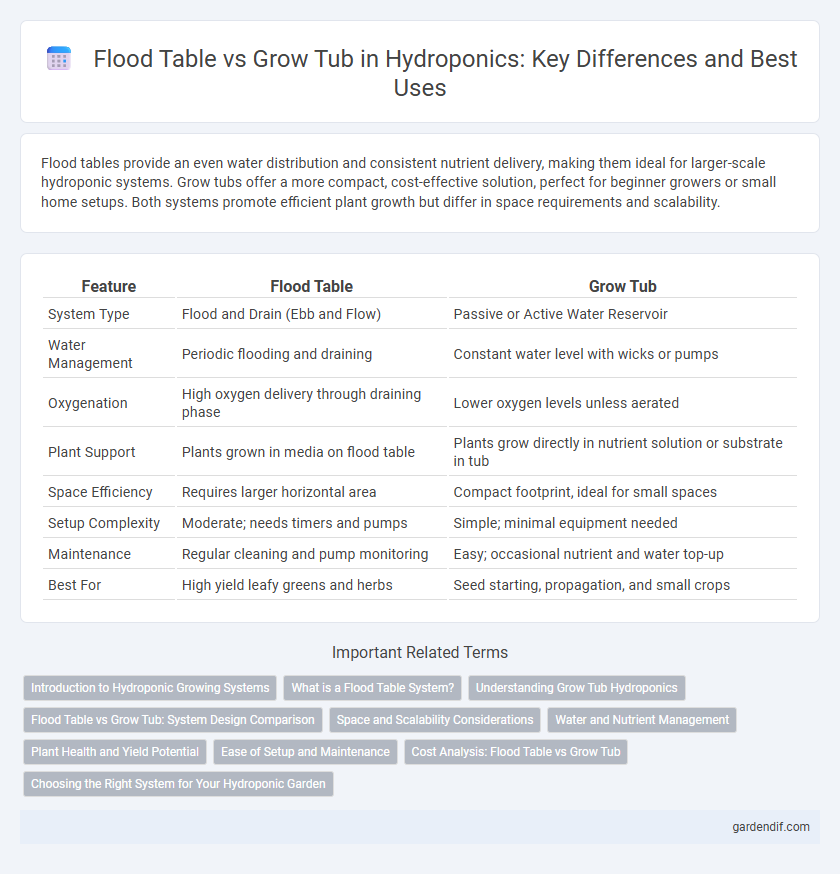
Flood Table vs Grow Tub Illustration
Flood tables provide an even water distribution and consistent nutrient delivery, making them ideal for larger-scale hydroponic systems. Grow tubs offer a more compact, cost-effective solution, perfect for beginner growers or small home setups. Both systems promote efficient plant growth but differ in space requirements and scalability.
Table of Comparison
| Feature | Flood Table | Grow Tub |
|---|---|---|
| System Type | Flood and Drain (Ebb and Flow) | Passive or Active Water Reservoir |
| Water Management | Periodic flooding and draining | Constant water level with wicks or pumps |
| Oxygenation | High oxygen delivery through draining phase | Lower oxygen levels unless aerated |
| Plant Support | Plants grown in media on flood table | Plants grow directly in nutrient solution or substrate in tub |
| Space Efficiency | Requires larger horizontal area | Compact footprint, ideal for small spaces |
| Setup Complexity | Moderate; needs timers and pumps | Simple; minimal equipment needed |
| Maintenance | Regular cleaning and pump monitoring | Easy; occasional nutrient and water top-up |
| Best For | High yield leafy greens and herbs | Seed starting, propagation, and small crops |
Introduction to Hydroponic Growing Systems
Flood tables and grow tubs represent two fundamental hydroponic growing systems, each designed to optimize nutrient delivery and plant growth. Flood tables provide a shallow, even water layer that periodically floods and drains, ensuring oxygenation and nutrient absorption, ideal for leafy greens and herbs. Grow tubs typically serve as deep reservoir systems supporting larger plants with stable root hydration and tailored nutrient control.
What is a Flood Table System?
A flood table system is a type of hydroponic setup where plants grow on a flat, elevated surface periodically flooded with nutrient-rich water to promote optimal root hydration and oxygen exposure. This method efficiently recirculates water, minimizing waste and ensuring consistent nutrient delivery to crops such as lettuce, herbs, and strawberries. Compared to grow tubs, flood tables provide superior control over water distribution and drainage, enhancing plant growth and yield.
Understanding Grow Tub Hydroponics
Grow tub hydroponics uses shallow containers to support plant growth by flooding the tub with nutrient-rich water, promoting efficient oxygen exchange and root absorption. Compared to flood tables, grow tubs offer a more compact and scalable solution ideal for small-scale or home hydroponic systems. This method enhances water conservation and nutrient efficiency while maintaining optimal root zone moisture levels for diverse crops.
Flood Table vs Grow Tub: System Design Comparison
Flood tables utilize a shallow, flat surface with a controlled water flood-and-drain cycle, promoting oxygenation and nutrient absorption for plant roots, ideal for leafy greens and herbs. Grow tubs consist of deeper containers where nutrient solution is maintained at a constant level, supporting larger root zones suitable for fruiting plants and extensive root crops. Flood tables offer efficient water use and ease of access, while grow tubs provide greater nutrient stability and root space, influencing crop selection and system management.
Space and Scalability Considerations
Flood tables offer a large, flat surface ideal for cultivating many plants simultaneously, maximizing space efficiency in small to medium setups. Grow tubs are compact and modular, allowing easy scalability by adding more units without requiring extra floor area. Choosing between flood tables and grow tubs depends on available space and long-term expansion plans for hydroponic systems.
Water and Nutrient Management
Flood tables provide precise control over water and nutrient delivery by periodically flooding the root zone and allowing drainage, ensuring oxygenation and preventing nutrient buildup. Grow tubs offer a simpler system where water and nutrients are constantly available, but may require careful monitoring to avoid stagnation and nutrient imbalances. Effective water and nutrient management in hydroponics depends on selecting the appropriate system to maintain optimal root zone conditions and promote healthy plant growth.
Plant Health and Yield Potential
Flood tables provide consistent water and nutrient delivery by periodically flooding the root zone, which enhances oxygen availability and root health, leading to improved plant growth and higher yield potential. Grow tubs offer a stable environment for root development with controlled water retention, reducing stress on plants and supporting steady growth, though they may require more precise monitoring to prevent over- or under-watering. Optimal plant health and maximum yield depend on choosing a system that balances oxygenation and moisture control according to crop requirements.
Ease of Setup and Maintenance
Flood tables offer a straightforward setup with built-in water flooding mechanisms that simplify irrigation management, making them ideal for beginners in hydroponics. Grow tubs require manual adjustments for water levels and nutrient distribution, demanding more hands-on maintenance and monitoring. The ease of cleaning favors flood tables, as their flat surfaces and drainage systems reduce residue buildup compared to the deeper, harder-to-access grow tubs.
Cost Analysis: Flood Table vs Grow Tub
Flood tables typically require higher initial investment due to their larger structure and integrated plumbing systems, with costs ranging from $500 to $2,000 depending on size and materials. Grow tubs offer a more budget-friendly option, often priced between $50 and $300, making them suitable for small-scale or hobbyist hydroponic setups. Long-term operational costs also favor grow tubs as they consume less water and energy, reducing overall expenses.
Choosing the Right System for Your Hydroponic Garden
Flood tables provide even water distribution and are ideal for larger hydroponic setups, ensuring optimal root oxygenation and nutrient uptake. Grow tubs offer simplicity and cost-effectiveness, making them suitable for smaller gardens or beginners seeking an easy-to-maintain system. Selecting between flood tables and grow tubs depends on garden scale, budget, and desired automation level for efficient hydroponic growth.
Flood Table vs Grow Tub Infographic

 gardendif.com
gardendif.com